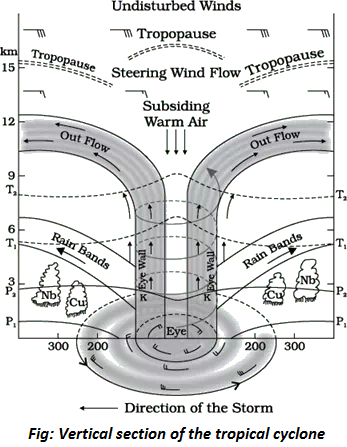-
09 Jan 2025
GS Paper 1
Geography
Day 34: Analyze the role of ocean warming in the increasing intensity and frequency of tropical cyclones. How does this trend impact coastal ecosystems and communities in India? (250 words)
Approach
- Briefly introduce the link between ocean warming and tropical cyclones.
- Discuss in detail how ocean warming intensifies cyclones.
- Analyze the impact on coastal ecosystems and communities with relevant examples and data.
- Conclude suitably.
Introduction
Tropical cyclones are among the most destructive natural disasters, fueled by warm ocean waters. The phenomenon of ocean warming, a direct consequence of climate change, has not only increased their frequency and intensity but also amplified their socio-economic and ecological impacts, particularly in vulnerable regions like India.
Body
Ocean Warming and Cyclone Intensification:
- Increased Sea Surface Temperatures (SSTs):
- Warm oceans provide more latent heat energy, which powers cyclones. For instance, the Bay of Bengal, with SSTs exceeding 28°C, is a hotspot for cyclone formation.
- Example: Cyclone Amphan (2020) intensified into a super cyclone within 18 hours due to exceptionally warm SSTs.
- Rapid Intensification:
- Ocean warming accelerates the pace at which cyclones strengthen, leaving limited time for preparedness.
- Example: Cyclone Tauktae (2021) escalated from a depression to a very severe cyclonic storm within a day.
- Shifting Cyclone Patterns:
- Traditionally, severe cyclones were concentrated in the Bay of Bengal, but warming has led to an increase in Arabian Sea cyclones (e.g., Cyclone Nisarga, 2020).
Impacts on Coastal Ecosystems:
- Mangrove Degradation:
- Mangroves, such as those in the Sundarbans, are critical buffers against cyclones. However, storm surges and salinity intrusion have degraded these ecosystems.
- Example: The Sundarbans lost significant mangrove cover after Cyclone Bulbul (2019).
- Coral Bleaching:
- Warmer waters and storm-induced sedimentation stress coral reefs, weakening their ability to protect coastlines.
- Example: The Lakshadweep Islands face coral degradation, threatening marine biodiversity and fisheries.
- Coastal Erosion and Habitat Loss:
- Repeated cyclonic activity accelerates erosion, shrinking habitats for both human and marine life.
- Example: Gahirmatha Beach in Odisha, a critical nesting site for olive ridley turtles, has been eroded by cyclones like Fani (2019).
Impacts on Coastal Communities:
- Economic Vulnerability:
- Fishermen and Farmers: Repeated cyclones damage fishing equipment, boats, and aquaculture setups, leading to income loss. Farmers face saline water intrusion in fields.
- Example: Cyclone Yaas (2021) caused damages to coastal infrastructure and livelihoods in Odisha and West Bengal.
- Displacement and Migration:
- Low-lying regions, such as the Sundarbans Delta, experience recurrent inundation, forcing people to migrate.
- Example: Post-Amphan, thousands of families in South 24 Parganas migrated due to destroyed homes and livelihoods.
- Health Risks:
- Waterborne diseases surge due to contaminated water after floods. Malnutrition increases as supply chains are disrupted.
- Example: Post-cyclone health crises were reported after Cyclone Fani, with widespread diarrheal outbreaks in Odisha.
Global and Indian Responses:
- Global Context:
- The Paris Agreement emphasizes capping global temperature rise to below 2°C to limit ocean warming.
- Indian Initiatives:
- India's cyclone early warning system, managed by the India Meteorological Department (IMD) provides timely alerts using advanced satellites, radars, and models, enabling effective disaster preparedness, evacuation, and mitigation to save lives and property.
- The National Cyclone Risk Mitigation Project (NCRMP) focuses on cyclone shelters, mangrove restoration, and resilient housing.
- The Mangrove Initiative for Shoreline Habitats & Tangible Incomes (MISHTI) is a government program focused on restoring and preserving mangrove ecosystems along India's coast to protect shorelines and support local communities.
Conclusion
Ocean warming is a critical driver of intensified tropical cyclones, posing severe challenges to India’s coastal ecosystems and communities. By integrating global climate action with local adaptation measures, such as eco-restoration and resilient infrastructure, India can effectively mitigate the risks and ensure sustainable coastal development





